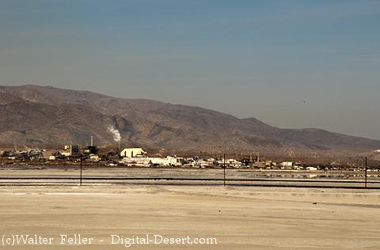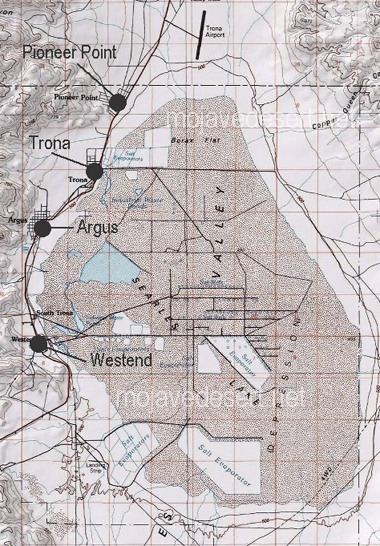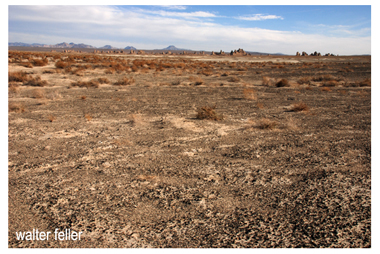Inyo County: Non-Metallic Minerals
Searles Lake Minerals
Covering more than 40 square miles of northwestern San Bernardino County and a small part of Inyo County, Searles Lake contains half the natural elements known to man. This mineral treasure chest was not recognized as such by the emigrants who camped on its shore and tasted of its brackish waters while escaping from Death Valley in 1850. They had already found and left behind a rich silver deposit. Drinkable water to them was much more valuable than any silver or brine. Nevertheless, it was the emigrant's lost silver deposit, the famed Lost Gunsight Mine that first lured Dennis Searles into this area and put him in a position to discover and develop the lake that now bears his name.Dennis Searles was among those searching for the Lost Gunsight Mine with Dr. S. G. George in 1860. Two years later, Dennis and his brother John were mining gold in the Slate Range. While there, they noticed that a large dry lake nearby contained borax. They went back to mining their gold, as borax wasn't quite the moneymaker as gold is, but by 1866 Indians had chased them all away from the Slate Range.
In the 1870s the Searles brothers were in Nevada, where they saw F. M. Smith successfully mining borax from a marsh. Dennis and John ran back to their lake, staked claims, and formed the San Bernardino Borax Mining Company in 1873. That year they scraped together a million pounds of borax and sold it for $200,000.
Mining law regarding placer deposits limited the Searles brothers to 160 acres, but they were able to control the entire lake by discovering and monopolizing the closest source of water, some seven miles from their plant. Most of their competitors were required to sell out sooner or later and the Searles brothers' early profits were largely the results of harvesting the borax already gathered into piles by their competition. The San Bernardino Borax Mining Company operated until 1897 when John Searles died. In 1898 Francis Smith bought the 100 ton a month plant and closed it. The equipment was moved for use at Smith's richer Daggett and Borate deposits.
Trona was discovered in Searles Lake in 1905, and that year the California Trona Company, with a $50,000 loan from Goldfields American Development, began buying up claims on Searles Lake. In 1913 the California Trona Company became the American Trona Corporation. Raymond Ashton began building a railroad from Searles Station to the lake, the line (the Trona Railroad) being completed in March of 1914. A huge, heavily financed refinery was completed in October, 1916.
Baron Alfred de Ropp since 1908 had managed to make the Searles Lake operations pay. As manager of the Goldfields American Development Company, de Ropp was the man responsible for investing a million dollars to erect a refinery capable of extracting potash at a profit. His vision had paid off, but when he resigned in 1920, a lack of leadership was felt. The American Trona Corporation was reorganized later as the American Potash and Chemical Corporation, and this company operates the plant at Searles Lake today.
Current production is 1800 tons each day of sodium, potash, boron, lithium, bromine, liquid bromine and boric acid. The American Potash and Chemical Company operations at Trona are the only source of potash currently being mined in California. The Trona plant is a 32 million dollar investment employing 1 ,500 people. Patented claims cover 2,560 acres of Searles Lake with 3,400 additional acres being leased from the federal government.
A rival plant to the American Potash and Chemical Company operated briefly for a four year period from 1916 until 1920. The Borosolvay Plant was operated by the Solvay Process Company of New York. Located 2 1/2 miles south of Trona at Borosolvay, while in operation the plant produced 200 tons of potash a month. In addition to the aforementioned minerals, sodium carbonate is also recovered from Searles Lake by the American Potash and Chemical Company and the West End Chemical Company. The West End Chemical Company originally mined borax with poor results when the company was organized by Francis Smith in 1920. Three years later the refinery was rebuilt to recover soda ash in addition to the borax, and it has been successful ever since. The process used to recover soda ash and borax involves injecting the lake brine with carbon dioxide gas, obtained by burning limestone from a nearby deposit. The bicarbonate produced is dried and heated in furnaces where it becomes a fluffy brown soda ash. In its coarse state this is used in the manufacture of glass.
Searles Lake's estimated mineral production potential is staggering. Thirty-two square miles of the lake are considered worth commercial interest. Each of these 32 square miles contain an estimated 100 million tons of alkali salts. This supply is expected to last for several generations.
John Searles
Borax
Searles Dry Lake
 Trona, California
Trona, California

Searles Valley
(...)